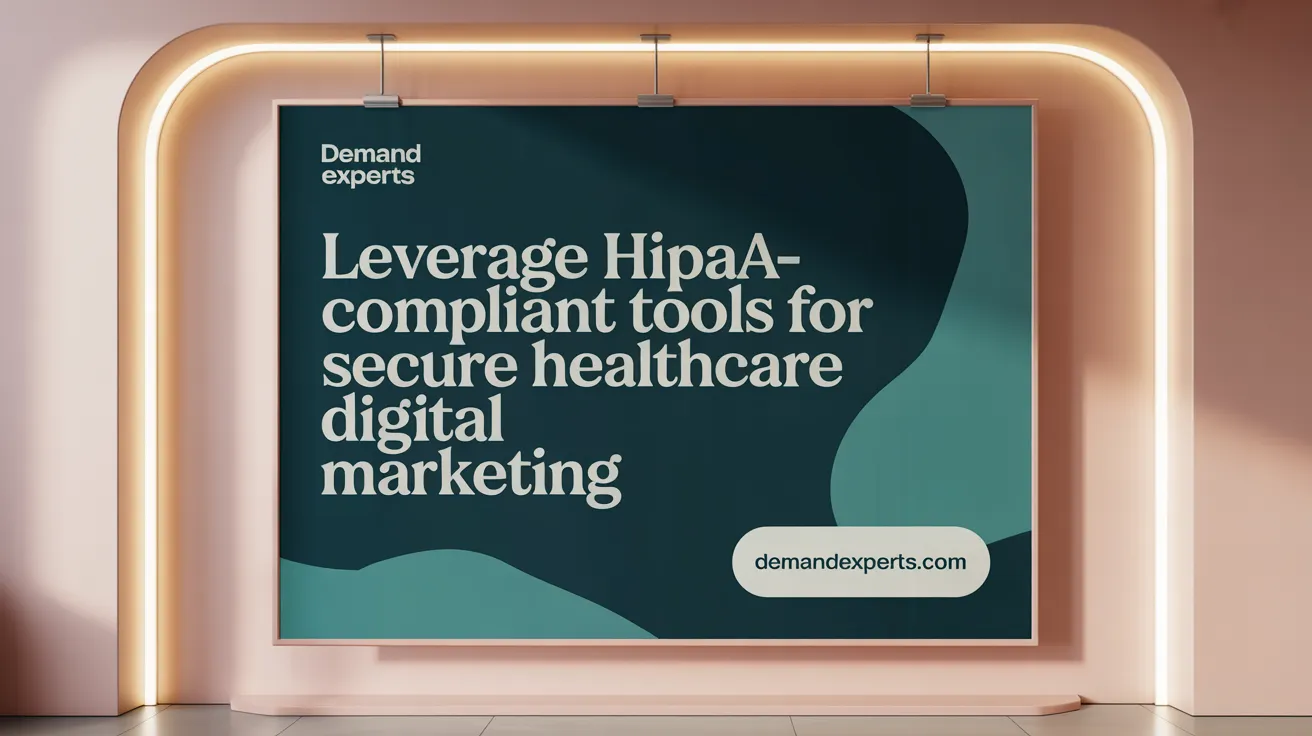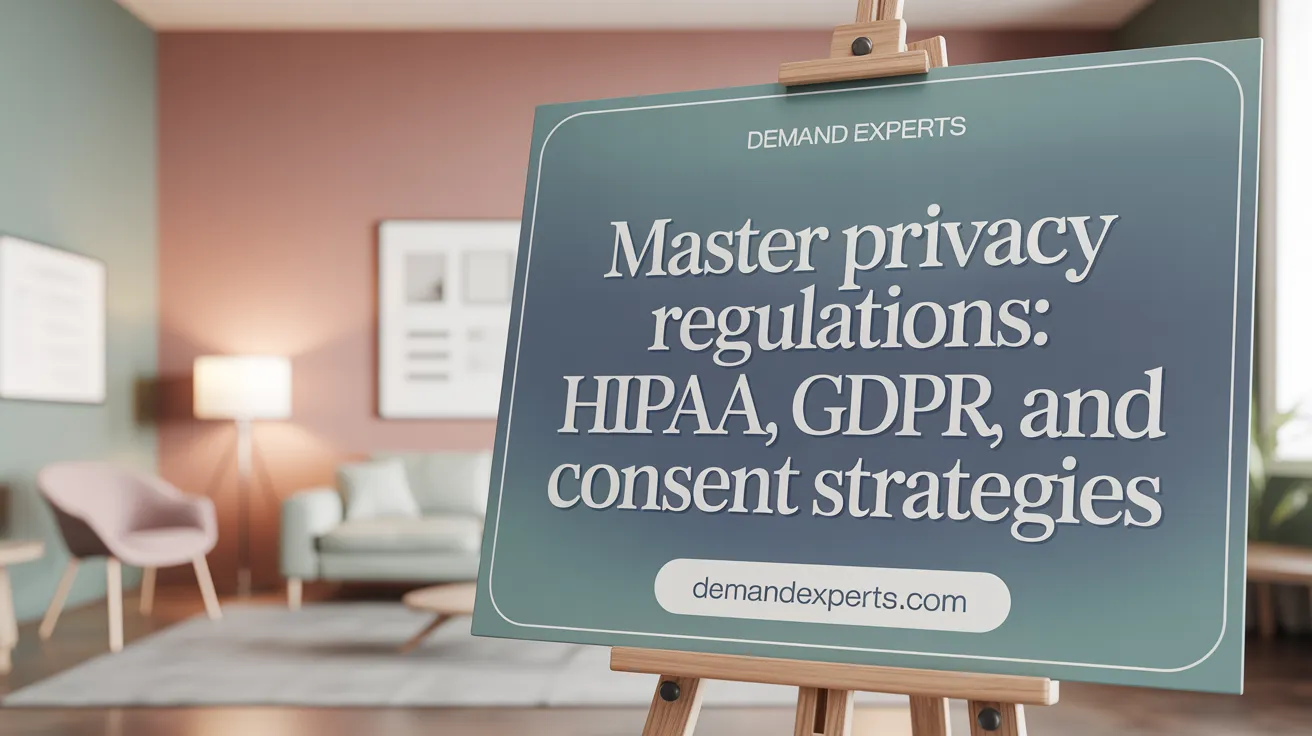Understanding the Foundations of Healthcare Advertising Compliance
Healthcare digital advertising operates within a stringent regulatory framework designed to protect consumers and ensure truthful marketing practices. This article explores the essential guidelines, regulations, and best practices digital advertisers must adhere to when navigating healthcare marketing. Addressing agency requirements such as those from the FDA, FTC, CMS, HIPAA, and GDPR, along with technical considerations and real-world examples, this piece offers comprehensive insights for healthcare marketers aiming for compliant and ethical advertising strategies.
Key Regulations Governing Healthcare Advertising
What are the key regulations and compliance guidelines governing healthcare advertising?
Healthcare advertising operates within a complex regulatory environment designed to protect consumers, ensure truthful information, and safeguard patient privacy. Major authorities involved include the Food and Drug Administration (FDA), Federal Trade Commission (FTC), and the Department of Health and Human Services' Office for Civil Rights under HIPAA.
The FDA mandates that advertisements for prescription drugs and medical devices must be truthful, not misleading, and include important risk information along with efficacy claims. This ensures consumers are well-informed about both benefits and possible side effects.
The FTC focuses on truth-in-advertising laws, emphasizing that all healthcare claims must be substantiated with evidence, and endorsers must disclose any material connections. It also sets guidelines for endorsements and testimonials, requiring transparency and honesty.
HIPAA introduces strict privacy standards on how healthcare data can be used and shared in marketing efforts. It requires explicit patient consent before using identifiable health information for promotional activities, and all data must be handled securely through encrypted communications and HIPAA-compliant tools.
In addition to federal oversight, state and local laws may impose further restrictions on healthcare advertising, especially concerning testimonials, disclosures, and the use of patient information. Platforms like Google and Facebook also have internal policies that advertisers must adhere to.
Ongoing compliance involves regular monitoring and updating of marketing practices, staff training on regulations, and choosing compliant technology solutions to avoid penalties, which can be substantial, reaching millions of dollars for violations.
In summary, healthcare marketers must navigate FDA's safety and efficacy disclosures, FTC’s truthfulness and endorsement rules, HIPAA's privacy protections, and local laws to develop responsible, transparent, and compliant advertising campaigns.
Legal and Regulatory Standards Specific to Digital Healthcare Advertising

What legal and regulatory standards apply to digital advertising in healthcare?
Healthcare organizations engaging in digital advertising must navigate a complex landscape of regulations designed to protect patient rights and ensure truthful communication.
The Health Insurance Portability and Accountability Act (HIPAA) is central to compliance, establishing strict rules for handling Protected Health Information (PHI). Healthcare entities must obtain explicit patient consent before using PHI in marketing and ensure data is securely stored, transmitted, and viewed only by authorized personnel. Any use of electronic PHI (ePHI) involves encrypting data, signing Business Associate Agreements (BAAs) with vendors, and maintaining audit logs.
In addition, the Federal Trade Commission (FTC) enforces truth-in-advertising laws. Healthcare ads must be truthful, not misleading, and supported by evidence. When endorsements or testimonials are used, disclosures about relationships and compensation must be clear, transparent, and prominent.
The Food and Drug Administration (FDA) regulates advertising for prescription drugs and medical devices. It requires all marketing claims to be accurate, backed by scientific evidence, and include information about potential risks. Failure to comply can lead to significant sanctions.
State medical boards also influence digital marketing practices, setting standards for ethical advertising, including restrictions on the use of patient testimonials, social media practices, and professional appearance standards.
On the international level, the General Data Protection Regulation (GDPR) impacts healthcare providers serving EU citizens. It demands transparency about data collection, obtaining explicit consent, minimizing data use, and allowing patients to access, update, or delete their data.
To stay compliant, healthcare marketing teams should regularly monitor legal updates, train staff on regulatory requirements, and choose privacy-conscious tools for digital campaigns. Combining adherence to HIPAA, FTC, FDA, state, and international standards creates a robust framework for lawful and trustworthy digital health marketing.
HIPAA’s Impact on Healthcare Marketing and Advertising Practices

How do HIPAA regulations impact healthcare marketing and advertising?
HIPAA (Health Insurance Portability and Accountability Act) imposes strict rules on how healthcare organizations handle Protected Health Information (PHI) in marketing efforts. PHI includes any identifiable health data such as medical records, treatment details, or even personal information like contact details when linked to health info.
In marketing, HIPAA limits the use and disclosure of PHI without explicit patient consent. Healthcare providers must seek written authorization before using patient stories, testimonials, or images. This ensures that patient privacy rights are protected and organizations comply with legal standards.
When engaging in digital advertising, healthcare organizations need to choose HIPAA-compliant tools and platforms. This means signing Business Associate Agreements (BAAs) with vendors handling PHI, encrypting electronic data, and maintaining secure online communication channels. Failing to adhere can lead to heavy fines—up to $2.1 million annually for violations—and reputational damage.
Moreover, digital efforts such as social media posts and analytics must avoid using PHI unless data is properly de-identified. Using standard analytics platforms like Google Analytics is only permissible if they do not collect personal health data or PII, as they are not inherently HIPAA-compliant.
In summary, HIPAA's impact on healthcare marketing is profound, requiring organizations to adopt secure practices, obtain necessary consents, and ensure all digital communications prioritize patient privacy to avoid violations and substantial penalties.
Best Practices and Strategies for Ensuring Compliance in Healthcare Digital Advertising

What are the best practices and strategies to ensure compliance in healthcare digital advertising?
In the complex field of healthcare digital marketing, maintaining compliance with numerous regulations is crucial. Strategies start with understanding the legal landscape, including rules from the FDA, FTC, CMS, HIPAA, and the GDPR. Marketers must ensure that all claims about healthcare products and services are truthful, accurate, and free from misleading information. Clear disclosures about limitations and risks should be standard in all advertisements.
A core element is the ongoing education and training of staff involved in marketing activities. Regular training sessions can help team members stay updated on legal requirements and best practices. Establishing a review process before campaigns go live ensures all content complies with applicable laws and guidelines.
Using HIPAA-compliant tools and platforms is also essential. This includes secure websites with SSL encryption, encrypted email services, and analytics platforms that adhere to privacy standards. Third-party vendors should sign Business Associate Agreements (BAAs) to demonstrate compliance. Marketing emails and forms collecting patient data must be permission-based, encrypted, and stored securely.
Obtaining explicit written consent from patients before using their stories, testimonials, or images is a legal requirement, safeguarding patient rights and privacy.
Transparent privacy policies and clear disclosures build trust. These policies should explicitly state how patient data is collected, used, and stored, providing patients with options to access, update, or delete their information.
Continuous monitoring and audits of active campaigns help detect any potential compliance issues early. Partnering with vendors specializing in healthcare compliance and maintaining a culture of privacy awareness further mitigates risks.
Staying informed about the evolving regulatory landscape and implementing a proactive compliance-first mindset are key for sustainable success. Overall, a combination of thorough staff training, technological safeguards, transparent practices, and diligent oversight creates a strong foundation for compliant healthcare digital advertising.
Technical Guidelines and HIPAA-Compliant Tools for Digital Marketing

What technical guidelines and tools can assist in compliant healthcare digital marketing?
Healthcare organizations must follow strict technical standards to keep their digital marketing efforts within legal boundaries. One essential guideline is to use secure, HIPAA-compliant platforms that ensure encryption for data in transit and at rest. This means employing SSL encryption on websites, which secures information exchanged between users and servers, protecting sensitive health data from unauthorized access.
In addition, employing analytics platforms designed specifically for healthcare—such as Matomo or other tools that offer HIPAA compliance—is vital. Unlike general tools like Google Analytics, these platforms include features like role-based access controls, audit logs, and data encryption, ensuring that only authorized personnel handle Protected Health Information (PHI).
Another important aspect involves role-based access and audit logging. Assigning permissions based on user roles limits who can view or manipulate sensitive information. Audit logs record all activity, helping detect and prevent violations.
For communication channels, secure email services that encrypt messages are necessary. Sending PHI via email without encryption poses risks, so healthcare marketers should use HIPAA-compliant email platforms designed for secure communication. Telehealth interactions must also adhere to HIPAA standards, using encrypted, secure video platforms that restrict unauthorized access.
Finally, integrating these tools with a clear privacy policy, obtaining patient consent, and regularly monitoring compliance through audits are best practices. Using the right combination of secure technology and processes helps healthcare marketers protect patient data, uphold legal standards, and sustain trust in digital outreach efforts.
Navigating Patient Data Privacy: HIPAA, GDPR, and Consent Management

GDPR Requirements for EU Citizen Data
The General Data Protection Regulation (GDPR) governs how healthcare organizations handle personal data of EU citizens, extending its influence globally. GDPR emphasizes transparency, requiring organizations to inform patients about how their data is collected, stored, and used. It mandates data minimization, meaning only data strictly necessary for healthcare purposes should be collected. Additionally, GDPR grants patients rights to access, correct, delete, or restrict their data, fostering trust and compliance.
Explicit Consent and Data Minimization Principles
In healthcare marketing, securing explicit consent before collecting or using patient data is crucial. This means clear, understandable language explaining the purpose of data collection must be presented at the time of consent. Data minimization principles compel organizations to gather only the necessary information, avoiding over-collection. For example, when requesting patient testimonials, obtaining written consent is mandatory before using any identifiable stories or images in marketing campaigns.
Secure Handling of Patient Stories and Testimonials
Using patient stories or testimonials enhances authenticity but must be done carefully. Explicit written consent is required before sharing any personal health information, images, or identifiable details. It's advisable to anonymize stories when possible and ensure secure storage of consent documentation. Secure channels of communication, such as encrypted emails or secure websites, should be employed to protect sensitive content.
Role of Business Associate Agreements in Data Sharing
When third-party vendors handle protected health information (PHI), organizations must have Business Associate Agreements (BAAs) in place. These legal contracts specify vendor responsibilities, ensuring HIPAA compliance in data handling, storage, and security. Without a BAA, sharing PHI risks violations and penalties. Signed BAAs are essential for cloud services, analytics tools, and any external platforms involved in healthcare marketing.
Balancing Data Segmentation and Patient Privacy
Strategic segmentation allows marketers to analyze demographic and interest data without intruding on patient confidentiality. Segregating patient-specific information and only storing it in HIPAA-compliant systems reduces risk. Contextual advertising based on broader interests avoids using identifiable PHI, maintaining privacy while delivering targeted messages. Employing secure, segmented databases aligned with privacy regulations ensures both effective marketing and regulatory adherence.
| Aspect | Requirement | Best Practice | Additional Info |
|---|---|---|---|
| GDPR Compliance | Transparency and data rights | Clear privacy policies, patient access options | Extends to EU citizens worldwide |
| Consent | Explicit and informed | Obtain written consent before use | Necessary for testimonials and images |
| Data Storage | Secure and compliant | Use encrypted storage and secure platforms | Use HIPAA-compliant tools |
| Data Sharing | Business Associate Agreements | Sign BAAs with all vendors handling PHI | Crucial for third-party vendors |
| Data Segmentation | Privacy-preserving analysis | Analyze interest data separately from PHI | Minimize data exposure |
Understanding these regulations and practices helps healthcare organizations navigate complex privacy landscapes, assuring patients' trust while maintaining legal compliance.
Case Studies: Successes and Challenges in Healthcare Advertising Compliance

Can you provide real-world examples or case studies that highlight challenges and successes in healthcare advertising compliance?
Healthcare organizations encounter both obstacles and opportunities when aiming for compliance in digital marketing. A notable success is Priority Health, which integrated a HIPAA-compliant tracking system using Freshpaint's platform. This move allowed them to accurately measure campaign performance while safeguarding patient privacy. As a result, they achieved a 70% decrease in cost per lead, demonstrating how strict adherence to privacy laws can enhance marketing efficiency.
Another innovative case is Virtua Health's use of geofencing technology combined with vehicle wraps. By targeting specific geographic locations and retargeting audiences through digital ads, Virtua Health saw an 18.81% visit rate, maximizing outreach without compromising privacy or running afoul of regulations. This approach showcases how creative, compliant strategies can yield measurable success.
However, not all efforts are without risk. Some organizations have faced penalties, such as a telemedicine provider fined for GDPR cookie consent violations. This incident underscored the importance of transparent data collection practices and compliance with GDPR requirements—prompting the company to update its privacy policies and improve user consent mechanisms.
These examples illustrate a vital lesson: rigorous compliance measures are essential, but innovative strategies tailored to regulation can lead to substantial rewards. Staying ahead in healthcare marketing involves balancing effective outreach with strict legal adherence, ultimately fostering trust and achieving optimal outcomes in the highly regulated healthcare environment.
| Case Study | Strategy | Result | Challenges/Notes |
|---|---|---|---|
| Priority Health | HIPAA-compliant tracking with Freshpaint | 70% reduction in cost per lead | Ensured patient data privacy while measuring performance |
| Virtua Health | Geofencing + vehicle wraps | 18.81% visit rate | Successful integration of physical and digital targeting |
| Telemedicine Provider | GDPR cookie consent updates | Avoided fines | Highlighted importance of transparent data practices |
In conclusion, these cases demonstrate that adherence to privacy laws like HIPAA and GDPR, combined with innovative marketing techniques, can lead to successful and compliant healthcare campaigns.
Strategic Roadmap for Achieving HIPAA-Compliant Digital Marketing

Introduction to Compliance Planning
Creating a compliant digital marketing strategy within healthcare requires careful planning, ongoing auditing, and proactive adjustments. A well-structured 90-day plan can guide organizations through essential steps to ensure adherence to HIPAA regulations and protect patient privacy.
90-Day Phased Plan for Compliance Auditing and Vendor Review
In the first month, healthcare organizations should conduct an extensive audit of existing marketing tools, platforms, and workflows to identify any gaps in HIPAA compliance. This includes reviewing data collection practices, security measures, and vendor agreements.
Following the audit, organizations must review all third-party vendors to ensure they sign Business Associate Agreements (BAAs). Non-compliant tools or services should be replaced or upgraded to align with HIPAA standards. This proactive approach minimizes legal risks and sets a foundation for secure digital marketing.
Replacing Non-Compliant Marketing Tools and Platforms
During months two and three, replace or upgrade any non-compliant technologies. Popular analytics platforms like Google Analytics may need modifications—such as de-identification features or switching to privacy-first alternatives like Matomo. Any tools handling PHI must encrypt data, restrict access, and have BAAs.
Secure forms, landing pages, and communication channels—such as encrypted email providers—should be implemented or improved to meet HIPAA’s encryption requirements. PHI transmission must be secure, with all non-compliant integrations phased out.
Staff Training Programs Fostering Privacy Culture
Simultaneously, staff training is crucial. Educational sessions should focus on HIPAA principles, best security practices, and proper handling of PHI. Training programs help foster a privacy-aware culture, ensuring everyone understands their role in data security.
Regular updates, refreshers, and compliance certifications reinforce this culture and keep staff informed about evolving regulations and internal policies.
Establishing Ongoing Review, Audit, and Adaptation Processes
After initial implementation, set up ongoing review protocols. This involves scheduled audits of marketing tools, security practices, and vendor compliance statuses.
Create a clear process for reporting security incidents or compliance concerns. Regularly review policies, update training materials, and adapt procedures to new regulations or threats. Staying vigilant ensures continued HIPAA compliance and data security.
Creating Security-First Infrastructure and Policies
Finally, develop a comprehensive infrastructure centered around security. This includes deploying encrypted communication channels, secure patient portals, and role-based access controls.
Company-wide policies should define standards for data handling, vendor management, and incident response. Combining technology with well-communicated policies creates a resilient environment that supports compliant and trustworthy healthcare marketing efforts.
| Step | Main Focus | Activities | Timeline |
|---|---|---|---|
| 1 | Audit & Review | Assess existing tools and workflows, review vendor agreements | 1st month |
| 2 | Tool Replacement | Upgrade non-compliant tools, implement HIPAA-secure platforms | 2nd month |
| 3 | Staff Training | Conduct HIPAA-focused training sessions | Throughout period |
| 4 | Continuous Review | Establish audit schedules, incident reporting, policy updates | 3rd month |
| 5 | Infrastructure Building | Deploy encryption, secure portals, access controls | Ongoing |
Achieving compliance is an ongoing journey. Implementing these measures within a structured 90-day roadmap ensures healthcare organizations can offer effective, privacy-conscious digital marketing that aligns with legal obligations and patient trust.
Embracing Compliance as a Cornerstone for Healthcare Digital Advertising Success
Adhering to healthcare compliance guidelines is not merely a regulatory obligation but a strategic imperative for digital advertisers in the healthcare sector. By understanding and integrating legal standards from agencies like the FDA, FTC, HIPAA, CMS, and GDPR with best practices in consent management, technical safeguards, and transparent communication, healthcare marketers can build trust, protect patient data, and mitigate risk. The use of compliant technologies combined with continuous education and audits sustains long-term adherence amidst evolving regulations. Ultimately, embracing a culture of compliance enables healthcare organizations to innovate confidently while safeguarding patient privacy and maintaining ethical marketing standards.
References
- Navigating Compliance: Digital Advertising in the Healthcare ...
- HIPAA, marketing and advertising: How to run compliant ...
- Healthcare Marketing Compliance: Key Strategies for Success
- Digital marketing HIPAA compliance: A guide for independent ...
- HIPAA-Compliant Healthcare Marketing: Digital Strategies ...
- Navigating Compliance: Digital Advertising in the Healthcare ...
- Healthcare Marketing Compliance: Key Strategies for Success
- Healthcare Advertising Regulations You Need to Know
- Healthcare Marketing Compliance: Key Strategies for Success
Understanding the Foundations of Healthcare Advertising Compliance
Healthcare digital advertising operates within a stringent regulatory framework designed to protect consumers and ensure truthful marketing practices. This article explores the essential guidelines, regulations, and best practices digital advertisers must adhere to when navigating healthcare marketing. Addressing agency requirements such as those from the FDA, FTC, CMS, HIPAA, and GDPR, along with technical considerations and real-world examples, this piece offers comprehensive insights for healthcare marketers aiming for compliant and ethical advertising strategies.
Key Regulations Governing Healthcare Advertising
What are the key regulations and compliance guidelines governing healthcare advertising?
Healthcare advertising operates within a complex regulatory environment designed to protect consumers, ensure truthful information, and safeguard patient privacy. Major authorities involved include the Food and Drug Administration (FDA), Federal Trade Commission (FTC), and the Department of Health and Human Services' Office for Civil Rights under HIPAA.
The FDA mandates that advertisements for prescription drugs and medical devices must be truthful, not misleading, and include important risk information along with efficacy claims. This ensures consumers are well-informed about both benefits and possible side effects.
The FTC focuses on truth-in-advertising laws, emphasizing that all healthcare claims must be substantiated with evidence, and endorsers must disclose any material connections. It also sets guidelines for endorsements and testimonials, requiring transparency and honesty.
HIPAA introduces strict privacy standards on how healthcare data can be used and shared in marketing efforts. It requires explicit patient consent before using identifiable health information for promotional activities, and all data must be handled securely through encrypted communications and HIPAA-compliant tools.
In addition to federal oversight, state and local laws may impose further restrictions on healthcare advertising, especially concerning testimonials, disclosures, and the use of patient information. Platforms like Google and Facebook also have internal policies that advertisers must adhere to.
Ongoing compliance involves regular monitoring and updating of marketing practices, staff training on regulations, and choosing compliant technology solutions to avoid penalties, which can be substantial, reaching millions of dollars for violations.
In summary, healthcare marketers must navigate FDA's safety and efficacy disclosures, FTC’s truthfulness and endorsement rules, HIPAA's privacy protections, and local laws to develop responsible, transparent, and compliant advertising campaigns.
Legal and Regulatory Standards Specific to Digital Healthcare Advertising

What legal and regulatory standards apply to digital advertising in healthcare?
Healthcare organizations engaging in digital advertising must navigate a complex landscape of regulations designed to protect patient rights and ensure truthful communication.
The Health Insurance Portability and Accountability Act (HIPAA) is central to compliance, establishing strict rules for handling Protected Health Information (PHI). Healthcare entities must obtain explicit patient consent before using PHI in marketing and ensure data is securely stored, transmitted, and viewed only by authorized personnel. Any use of electronic PHI (ePHI) involves encrypting data, signing Business Associate Agreements (BAAs) with vendors, and maintaining audit logs.
In addition, the Federal Trade Commission (FTC) enforces truth-in-advertising laws. Healthcare ads must be truthful, not misleading, and supported by evidence. When endorsements or testimonials are used, disclosures about relationships and compensation must be clear, transparent, and prominent.
The Food and Drug Administration (FDA) regulates advertising for prescription drugs and medical devices. It requires all marketing claims to be accurate, backed by scientific evidence, and include information about potential risks. Failure to comply can lead to significant sanctions.
State medical boards also influence digital marketing practices, setting standards for ethical advertising, including restrictions on the use of patient testimonials, social media practices, and professional appearance standards.
On the international level, the General Data Protection Regulation (GDPR) impacts healthcare providers serving EU citizens. It demands transparency about data collection, obtaining explicit consent, minimizing data use, and allowing patients to access, update, or delete their data.
To stay compliant, healthcare marketing teams should regularly monitor legal updates, train staff on regulatory requirements, and choose privacy-conscious tools for digital campaigns. Combining adherence to HIPAA, FTC, FDA, state, and international standards creates a robust framework for lawful and trustworthy digital health marketing.
HIPAA’s Impact on Healthcare Marketing and Advertising Practices

How do HIPAA regulations impact healthcare marketing and advertising?
HIPAA (Health Insurance Portability and Accountability Act) imposes strict rules on how healthcare organizations handle Protected Health Information (PHI) in marketing efforts. PHI includes any identifiable health data such as medical records, treatment details, or even personal information like contact details when linked to health info.
In marketing, HIPAA limits the use and disclosure of PHI without explicit patient consent. Healthcare providers must seek written authorization before using patient stories, testimonials, or images. This ensures that patient privacy rights are protected and organizations comply with legal standards.
When engaging in digital advertising, healthcare organizations need to choose HIPAA-compliant tools and platforms. This means signing Business Associate Agreements (BAAs) with vendors handling PHI, encrypting electronic data, and maintaining secure online communication channels. Failing to adhere can lead to heavy fines—up to $2.1 million annually for violations—and reputational damage.
Moreover, digital efforts such as social media posts and analytics must avoid using PHI unless data is properly de-identified. Using standard analytics platforms like Google Analytics is only permissible if they do not collect personal health data or PII, as they are not inherently HIPAA-compliant.
In summary, HIPAA's impact on healthcare marketing is profound, requiring organizations to adopt secure practices, obtain necessary consents, and ensure all digital communications prioritize patient privacy to avoid violations and substantial penalties.
Best Practices and Strategies for Ensuring Compliance in Healthcare Digital Advertising

What are the best practices and strategies to ensure compliance in healthcare digital advertising?
In the complex field of healthcare digital marketing, maintaining compliance with numerous regulations is crucial. Strategies start with understanding the legal landscape, including rules from the FDA, FTC, CMS, HIPAA, and the GDPR. Marketers must ensure that all claims about healthcare products and services are truthful, accurate, and free from misleading information. Clear disclosures about limitations and risks should be standard in all advertisements.
A core element is the ongoing education and training of staff involved in marketing activities. Regular training sessions can help team members stay updated on legal requirements and best practices. Establishing a review process before campaigns go live ensures all content complies with applicable laws and guidelines.
Using HIPAA-compliant tools and platforms is also essential. This includes secure websites with SSL encryption, encrypted email services, and analytics platforms that adhere to privacy standards. Third-party vendors should sign Business Associate Agreements (BAAs) to demonstrate compliance. Marketing emails and forms collecting patient data must be permission-based, encrypted, and stored securely.
Obtaining explicit written consent from patients before using their stories, testimonials, or images is a legal requirement, safeguarding patient rights and privacy.
Transparent privacy policies and clear disclosures build trust. These policies should explicitly state how patient data is collected, used, and stored, providing patients with options to access, update, or delete their information.
Continuous monitoring and audits of active campaigns help detect any potential compliance issues early. Partnering with vendors specializing in healthcare compliance and maintaining a culture of privacy awareness further mitigates risks.
Staying informed about the evolving regulatory landscape and implementing a proactive compliance-first mindset are key for sustainable success. Overall, a combination of thorough staff training, technological safeguards, transparent practices, and diligent oversight creates a strong foundation for compliant healthcare digital advertising.
Technical Guidelines and HIPAA-Compliant Tools for Digital Marketing

What technical guidelines and tools can assist in compliant healthcare digital marketing?
Healthcare organizations must follow strict technical standards to keep their digital marketing efforts within legal boundaries. One essential guideline is to use secure, HIPAA-compliant platforms that ensure encryption for data in transit and at rest. This means employing SSL encryption on websites, which secures information exchanged between users and servers, protecting sensitive health data from unauthorized access.
In addition, employing analytics platforms designed specifically for healthcare—such as Matomo or other tools that offer HIPAA compliance—is vital. Unlike general tools like Google Analytics, these platforms include features like role-based access controls, audit logs, and data encryption, ensuring that only authorized personnel handle Protected Health Information (PHI).
Another important aspect involves role-based access and audit logging. Assigning permissions based on user roles limits who can view or manipulate sensitive information. Audit logs record all activity, helping detect and prevent violations.
For communication channels, secure email services that encrypt messages are necessary. Sending PHI via email without encryption poses risks, so healthcare marketers should use HIPAA-compliant email platforms designed for secure communication. Telehealth interactions must also adhere to HIPAA standards, using encrypted, secure video platforms that restrict unauthorized access.
Finally, integrating these tools with a clear privacy policy, obtaining patient consent, and regularly monitoring compliance through audits are best practices. Using the right combination of secure technology and processes helps healthcare marketers protect patient data, uphold legal standards, and sustain trust in digital outreach efforts.
Navigating Patient Data Privacy: HIPAA, GDPR, and Consent Management

GDPR Requirements for EU Citizen Data
The General Data Protection Regulation (GDPR) governs how healthcare organizations handle personal data of EU citizens, extending its influence globally. GDPR emphasizes transparency, requiring organizations to inform patients about how their data is collected, stored, and used. It mandates data minimization, meaning only data strictly necessary for healthcare purposes should be collected. Additionally, GDPR grants patients rights to access, correct, delete, or restrict their data, fostering trust and compliance.
Explicit Consent and Data Minimization Principles
In healthcare marketing, securing explicit consent before collecting or using patient data is crucial. This means clear, understandable language explaining the purpose of data collection must be presented at the time of consent. Data minimization principles compel organizations to gather only the necessary information, avoiding over-collection. For example, when requesting patient testimonials, obtaining written consent is mandatory before using any identifiable stories or images in marketing campaigns.
Secure Handling of Patient Stories and Testimonials
Using patient stories or testimonials enhances authenticity but must be done carefully. Explicit written consent is required before sharing any personal health information, images, or identifiable details. It's advisable to anonymize stories when possible and ensure secure storage of consent documentation. Secure channels of communication, such as encrypted emails or secure websites, should be employed to protect sensitive content.
Role of Business Associate Agreements in Data Sharing
When third-party vendors handle protected health information (PHI), organizations must have Business Associate Agreements (BAAs) in place. These legal contracts specify vendor responsibilities, ensuring HIPAA compliance in data handling, storage, and security. Without a BAA, sharing PHI risks violations and penalties. Signed BAAs are essential for cloud services, analytics tools, and any external platforms involved in healthcare marketing.
Balancing Data Segmentation and Patient Privacy
Strategic segmentation allows marketers to analyze demographic and interest data without intruding on patient confidentiality. Segregating patient-specific information and only storing it in HIPAA-compliant systems reduces risk. Contextual advertising based on broader interests avoids using identifiable PHI, maintaining privacy while delivering targeted messages. Employing secure, segmented databases aligned with privacy regulations ensures both effective marketing and regulatory adherence.
| Aspect | Requirement | Best Practice | Additional Info |
|---|---|---|---|
| GDPR Compliance | Transparency and data rights | Clear privacy policies, patient access options | Extends to EU citizens worldwide |
| Consent | Explicit and informed | Obtain written consent before use | Necessary for testimonials and images |
| Data Storage | Secure and compliant | Use encrypted storage and secure platforms | Use HIPAA-compliant tools |
| Data Sharing | Business Associate Agreements | Sign BAAs with all vendors handling PHI | Crucial for third-party vendors |
| Data Segmentation | Privacy-preserving analysis | Analyze interest data separately from PHI | Minimize data exposure |
Understanding these regulations and practices helps healthcare organizations navigate complex privacy landscapes, assuring patients' trust while maintaining legal compliance.
Case Studies: Successes and Challenges in Healthcare Advertising Compliance

Can you provide real-world examples or case studies that highlight challenges and successes in healthcare advertising compliance?
Healthcare organizations encounter both obstacles and opportunities when aiming for compliance in digital marketing. A notable success is Priority Health, which integrated a HIPAA-compliant tracking system using Freshpaint's platform. This move allowed them to accurately measure campaign performance while safeguarding patient privacy. As a result, they achieved a 70% decrease in cost per lead, demonstrating how strict adherence to privacy laws can enhance marketing efficiency.
Another innovative case is Virtua Health's use of geofencing technology combined with vehicle wraps. By targeting specific geographic locations and retargeting audiences through digital ads, Virtua Health saw an 18.81% visit rate, maximizing outreach without compromising privacy or running afoul of regulations. This approach showcases how creative, compliant strategies can yield measurable success.
However, not all efforts are without risk. Some organizations have faced penalties, such as a telemedicine provider fined for GDPR cookie consent violations. This incident underscored the importance of transparent data collection practices and compliance with GDPR requirements—prompting the company to update its privacy policies and improve user consent mechanisms.
These examples illustrate a vital lesson: rigorous compliance measures are essential, but innovative strategies tailored to regulation can lead to substantial rewards. Staying ahead in healthcare marketing involves balancing effective outreach with strict legal adherence, ultimately fostering trust and achieving optimal outcomes in the highly regulated healthcare environment.
| Case Study | Strategy | Result | Challenges/Notes |
|---|---|---|---|
| Priority Health | HIPAA-compliant tracking with Freshpaint | 70% reduction in cost per lead | Ensured patient data privacy while measuring performance |
| Virtua Health | Geofencing + vehicle wraps | 18.81% visit rate | Successful integration of physical and digital targeting |
| Telemedicine Provider | GDPR cookie consent updates | Avoided fines | Highlighted importance of transparent data practices |
In conclusion, these cases demonstrate that adherence to privacy laws like HIPAA and GDPR, combined with innovative marketing techniques, can lead to successful and compliant healthcare campaigns.
Strategic Roadmap for Achieving HIPAA-Compliant Digital Marketing

Introduction to Compliance Planning
Creating a compliant digital marketing strategy within healthcare requires careful planning, ongoing auditing, and proactive adjustments. A well-structured 90-day plan can guide organizations through essential steps to ensure adherence to HIPAA regulations and protect patient privacy.
90-Day Phased Plan for Compliance Auditing and Vendor Review
In the first month, healthcare organizations should conduct an extensive audit of existing marketing tools, platforms, and workflows to identify any gaps in HIPAA compliance. This includes reviewing data collection practices, security measures, and vendor agreements.
Following the audit, organizations must review all third-party vendors to ensure they sign Business Associate Agreements (BAAs). Non-compliant tools or services should be replaced or upgraded to align with HIPAA standards. This proactive approach minimizes legal risks and sets a foundation for secure digital marketing.
Replacing Non-Compliant Marketing Tools and Platforms
During months two and three, replace or upgrade any non-compliant technologies. Popular analytics platforms like Google Analytics may need modifications—such as de-identification features or switching to privacy-first alternatives like Matomo. Any tools handling PHI must encrypt data, restrict access, and have BAAs.
Secure forms, landing pages, and communication channels—such as encrypted email providers—should be implemented or improved to meet HIPAA’s encryption requirements. PHI transmission must be secure, with all non-compliant integrations phased out.
Staff Training Programs Fostering Privacy Culture
Simultaneously, staff training is crucial. Educational sessions should focus on HIPAA principles, best security practices, and proper handling of PHI. Training programs help foster a privacy-aware culture, ensuring everyone understands their role in data security.
Regular updates, refreshers, and compliance certifications reinforce this culture and keep staff informed about evolving regulations and internal policies.
Establishing Ongoing Review, Audit, and Adaptation Processes
After initial implementation, set up ongoing review protocols. This involves scheduled audits of marketing tools, security practices, and vendor compliance statuses.
Create a clear process for reporting security incidents or compliance concerns. Regularly review policies, update training materials, and adapt procedures to new regulations or threats. Staying vigilant ensures continued HIPAA compliance and data security.
Creating Security-First Infrastructure and Policies
Finally, develop a comprehensive infrastructure centered around security. This includes deploying encrypted communication channels, secure patient portals, and role-based access controls.
Company-wide policies should define standards for data handling, vendor management, and incident response. Combining technology with well-communicated policies creates a resilient environment that supports compliant and trustworthy healthcare marketing efforts.
| Step | Main Focus | Activities | Timeline |
|---|---|---|---|
| 1 | Audit & Review | Assess existing tools and workflows, review vendor agreements | 1st month |
| 2 | Tool Replacement | Upgrade non-compliant tools, implement HIPAA-secure platforms | 2nd month |
| 3 | Staff Training | Conduct HIPAA-focused training sessions | Throughout period |
| 4 | Continuous Review | Establish audit schedules, incident reporting, policy updates | 3rd month |
| 5 | Infrastructure Building | Deploy encryption, secure portals, access controls | Ongoing |
Achieving compliance is an ongoing journey. Implementing these measures within a structured 90-day roadmap ensures healthcare organizations can offer effective, privacy-conscious digital marketing that aligns with legal obligations and patient trust.
Embracing Compliance as a Cornerstone for Healthcare Digital Advertising Success
Adhering to healthcare compliance guidelines is not merely a regulatory obligation but a strategic imperative for digital advertisers in the healthcare sector. By understanding and integrating legal standards from agencies like the FDA, FTC, HIPAA, CMS, and GDPR with best practices in consent management, technical safeguards, and transparent communication, healthcare marketers can build trust, protect patient data, and mitigate risk. The use of compliant technologies combined with continuous education and audits sustains long-term adherence amidst evolving regulations. Ultimately, embracing a culture of compliance enables healthcare organizations to innovate confidently while safeguarding patient privacy and maintaining ethical marketing standards.
References
- Navigating Compliance: Digital Advertising in the Healthcare ...
- HIPAA, marketing and advertising: How to run compliant ...
- Healthcare Marketing Compliance: Key Strategies for Success
- Digital marketing HIPAA compliance: A guide for independent ...
- HIPAA-Compliant Healthcare Marketing: Digital Strategies ...
- Navigating Compliance: Digital Advertising in the Healthcare ...
- Healthcare Marketing Compliance: Key Strategies for Success
- Healthcare Advertising Regulations You Need to Know
- Healthcare Marketing Compliance: Key Strategies for Success






